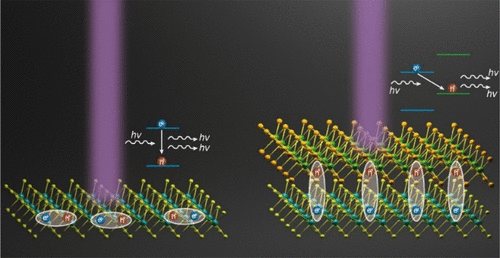当前位置:
X-MOL 学术
›
ACS Mater. Lett.
›
论文详情
Our official English website, www.x-mol.net, welcomes your
feedback! (Note: you will need to create a separate account there.)
Excitonic Lasers in Atomically Thin 2D Semiconductors
ACS Materials Letters ( IF 9.6 ) Pub Date : 2020-09-02 , DOI: 10.1021/acsmaterialslett.0c00277 Wen Wen 1 , Lishu Wu 1 , Ting Yu 1
ACS Materials Letters ( IF 9.6 ) Pub Date : 2020-09-02 , DOI: 10.1021/acsmaterialslett.0c00277 Wen Wen 1 , Lishu Wu 1 , Ting Yu 1
Affiliation

|
Two-dimensional (2D) atomically thin transition-metal dichalcogenides (TMD) and their van der Waals (vdW) heterostructures offer a platform with tightly bound intralayer/interlayer excitons for the on-chip fabrication of ultracompact nanolasers. Excitons in 2D TMD materials present a considerable binding energy of up to hundreds of meV, which permits a high Mott transition density of 1014 cm–2 and stable excitonic lasing under room-temperature operation and high pump fluences. Here, we review the recent progress on the lasing emission from intralayer excitons in TMD monolayers and interlayer excitons in vdW heterostructures incorporated with various high-quality optical cavities, including photonic-crystal, whispering-gallery-mode, distributed-feedback, distributed-Bragg-reflector cavities. Lasing emissions in TMD monolayers and heterostructures have been demonstrated by narrow emission peaks, a clear threshold for nonlinear amplification, time- and spatial coherence under either continuous-wave or pulsed light pumping. Finally, prospective and frontier research topics, including large-scale on-chip integration of TMD nanolasers, electrically pumped lasers, spin-polarized nanolasers, and exciton–polariton Bose–Einstein condensation (BEC) are highlighted.
中文翻译:

原子薄2D半导体中的激子激光器
二维(2D)原子薄的过渡金属二硫属化合物(TMD)及其范德华力(vdW)异质结构提供了一个平台,该平台具有紧密结合的层内/层间激子,可用于芯片上的超紧凑纳米激光制造。2D TMD材料中的激子呈现出高达数百meV的可观结合能,从而允许10 14 cm –2的高Mott跃迁密度在室温操作和高泵浦注量下稳定的激子激射。在这里,我们回顾了TMD单层的层内激子和vdW异质结构中的层间激子发射激光的最新进展,这些结构结合了各种高质量的光腔,包括光子晶体,耳语画廊模式,分布式反馈,分布式布拉格-反射腔。通过窄的发射峰,连续波或脉冲光泵浦下的非线性放大,时间和空间相干性的清晰阈值,已经证明了TMD单层和异质结构中的小量发射。最后,前瞻性和前沿研究主题包括TMD纳米激光器,电泵浦激光器,自旋极化纳米激光器的大规模片上集成,
更新日期:2020-10-05
中文翻译:

原子薄2D半导体中的激子激光器
二维(2D)原子薄的过渡金属二硫属化合物(TMD)及其范德华力(vdW)异质结构提供了一个平台,该平台具有紧密结合的层内/层间激子,可用于芯片上的超紧凑纳米激光制造。2D TMD材料中的激子呈现出高达数百meV的可观结合能,从而允许10 14 cm –2的高Mott跃迁密度在室温操作和高泵浦注量下稳定的激子激射。在这里,我们回顾了TMD单层的层内激子和vdW异质结构中的层间激子发射激光的最新进展,这些结构结合了各种高质量的光腔,包括光子晶体,耳语画廊模式,分布式反馈,分布式布拉格-反射腔。通过窄的发射峰,连续波或脉冲光泵浦下的非线性放大,时间和空间相干性的清晰阈值,已经证明了TMD单层和异质结构中的小量发射。最后,前瞻性和前沿研究主题包括TMD纳米激光器,电泵浦激光器,自旋极化纳米激光器的大规模片上集成,









































 京公网安备 11010802027423号
京公网安备 11010802027423号